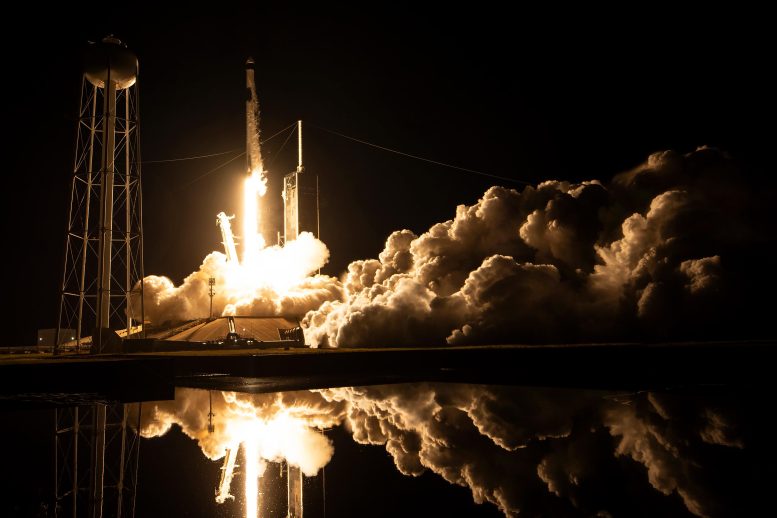
The SpaceX Falcon 9 rocket carrying the Dragon spacecraft lifts off from Launch Complex 39A at NASA’s Kennedy Space Center in Florida on Thursday, Nov. 9, 2023, on the company’s 29th commercial resupply services mission for the agency to the International Space Station. Liftoff was at 8:28 p.m. EST. Credit: SpaceX
NASA and the agency’s international partners are sending scientific investigations to the International Space Station on the 30th SpaceX commercial resupply services mission, including tests of technologies to monitor sea ice, automate 3D mapping, and create nanoparticle solar cells. The company’s Dragon cargo spacecraft is scheduled to launch from Cape Canaveral Space Force Station in Florida at 4:55 p.m. EDT on Thursday, March 21.
Read more about some of the research making the journey to the orbiting laboratory:
Plants off the Planet
Plants can be used in regenerative life support systems, to provide food, and to contribute to the well-being of astronauts on future deep space exploration missions. C4 Photosynthesis in Space (APEX-09) examines how microgravity affects the mechanisms by which two types of grasses, known as C3 and C4, capture carbon dioxide from the atmosphere.
“Plants respond to stressful conditions based on their genetic makeup and the environment,” said Pubudu Handakumbura, principal investigator with the Pacific Northwest National Laboratory. “We aim to uncover the molecular changes involved in plants exposed to spaceflight stressors and develop an understanding of the mechanisms of photosynthesis in space.” Results could clarify plant responses to stressful environments and inform the design of bio-regenerative support systems on future missions, as well as systems for plant growth on Earth.
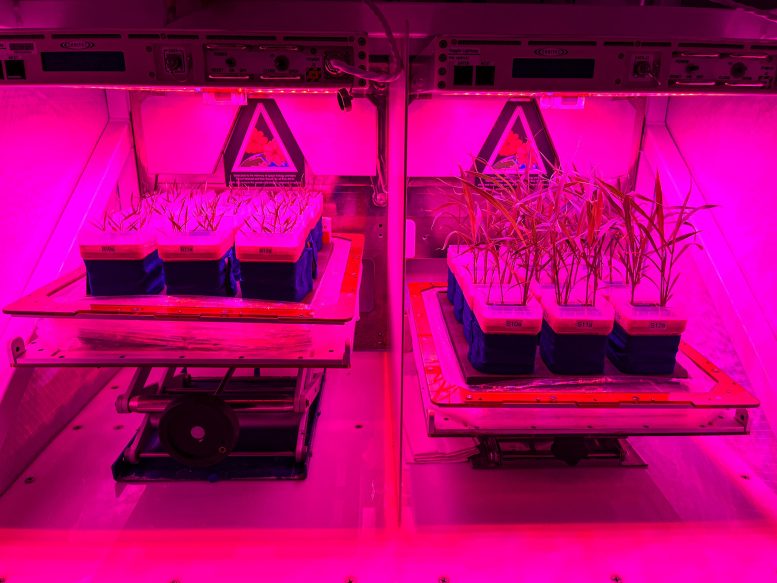
Brachypodium and Setaria were grown in the Plant Growth Systems (PGS) and tested under International Space Station environmental conditions using the Veggie units at NASA’s Kennedy Space Center during the APEX-09 Experiment Verification Test. Credit: Pubudu Handakumbura
Sensing the Sea
The ocean significantly affects the global climate. A technique called Global Navigation Satellite System reflectometry (GNSS-R), which receives satellite signals reflected from the surface of Earth, shows promise as a way to monitor ocean phenomena and improve climate models. Killick-1: A GNSS Reflectometry CubeSat for Measuring Sea Ice Thickness and Extent (Nanoracks KILLICK-1) tests using this technique to measure sea ice. The project supports development of space and science capabilities in Newfoundland and Labrador, Canada, by providing hands-on experience with space systems and Earth observation. More than 100 undergraduate and graduate engineering students participated in the project.
“The most exciting aspect of this project is that students have the opportunity to launch a mission into space,” said Desmond Power, a co-investigator with C-CORE of Canada. “It is also exciting to build a tiny satellite that does different things, including contributing to our knowledge of climate change.”
GNSS-R technology is low-cost, light, and energy efficient. Its potential applications on Earth include providing data for weather and climate models and improving the understanding of ocean phenomena such as surface winds and storm surge.
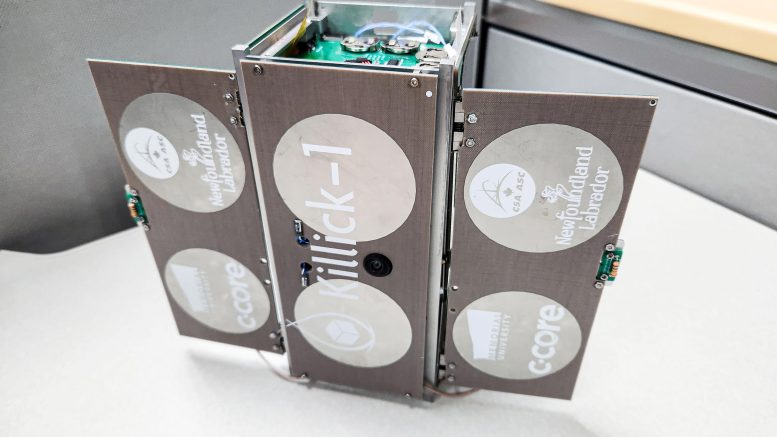
Fully assembled Nanoracks-Killick-1 CubeSat with its Global Navigation Satellite System Reflectometry (GNSS-R) antenna deployed. Nanoracks-Killick-1 measures sea ice using GNSS-R. Potential applications of GNSS-R include providing data for weather and climate models and improving understanding of ocean phenomena such as surface winds and storm surge. Credit: C-CORE and Memorial University.
Automated Autonomous Assistance
The Multi-resolution Scanner (MRS) Payload for Astrobee (Multi-Resolution Scanning) tests technology to automate 3D sensing, mapping, and situational awareness systems.
“Our MRS on an Astrobee free-flying robot will create 3D maps inside the space station,” said Marc Elmouttie, project lead with Australia’s national science agency, CSIRO, which developed the technology with The Boeing Company. “The scanner integrates technologies developed by our mining and robotics teams. By combining data from multiple sensors, we compensate for weaknesses in any one system. This provides very high-resolution 3D data and more accurate trajectory data to help us understand how the robot moves around in space.”
“The technology could be used to autonomously operate spacecraft with minimal or no human occupancy where robots must sense the environment and precisely maneuver, including the lunar Gateway space station,” said Principal Investigator Connie Miller of Boeing. “Other uses could be to inspect and maintain spacecraft and for autonomous vehicle operations on other celestial bodies. Results also support improvements in robotic technologies for harsh and dangerous environments on Earth.”
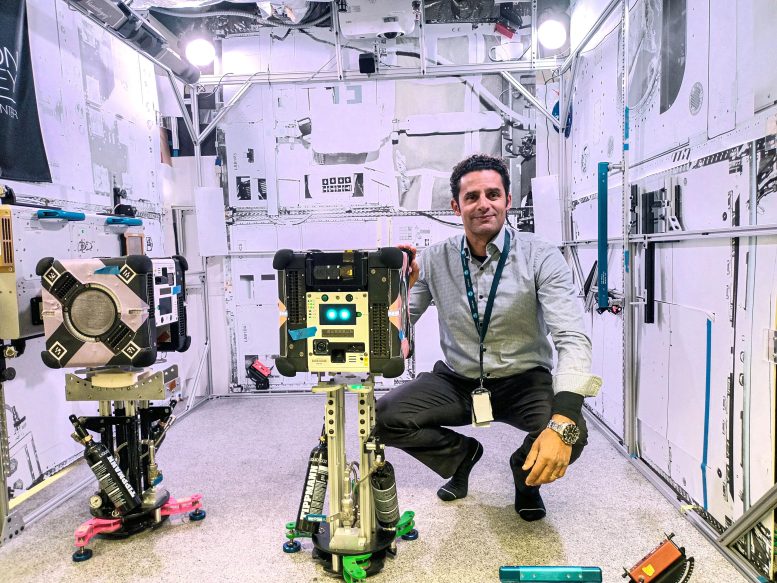
CSIRO Project Lead Marc Elmouttie with the MRS hardware and Astrobee robot ready for final pre-flight testing. Credit: NASA
Placement of Particles
The Nano Particle Haloing Suspension investigation examines how nanoparticles and microparticles interact within an electrical field. A process called nanoparticle haloing uses charged nanoparticles to enable precise particle arrangements that improve the efficiency of quantum-dot synthesized solar cells, according to Stuart J. Williams, principal investigator with the University of Louisville Department of Mechanical Engineering.
Quantum dots are tiny spheres of semiconductor material with the potential to convert sunlight into energy much more efficiently. Conducting these processes in microgravity provides insight into the relationship between shape, charge, concentration, and interaction of particles.
The investigation is supported by NASA’s Established Program to Stimulate Competitive Research (EPSCoR), which partners with government, higher education, and industry on projects to improve research infrastructure and research and development capacity and competitiveness.
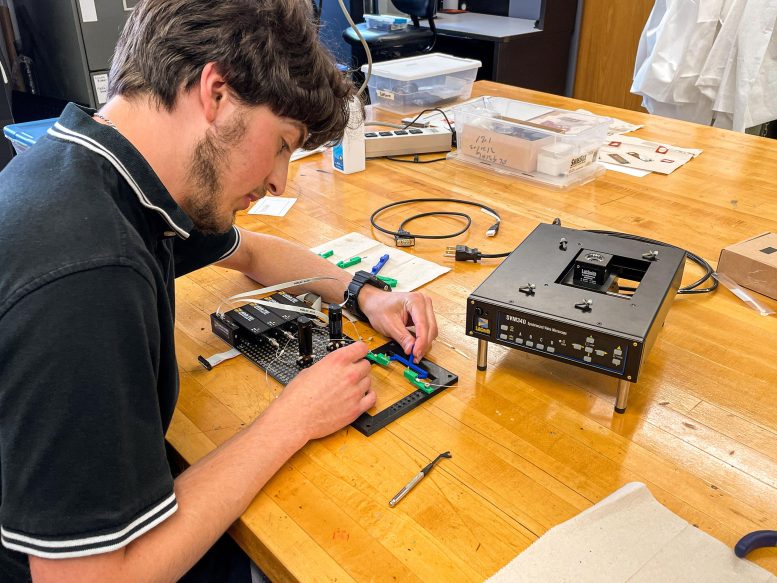
A capstone student assembles the microscope and fluid breadboard for the Nano Particle Haloing Suspension payload. This payload tests controlled assembly of nanoparticles in a solution of zirconia and titanium-dioxide coated silica. Effective demonstration could lead to applications in an enhanced solar cell generation technology known as quantum-dot solar synthesis. Credit: University of Louisville









Be the first to comment on "Innovative Science Experiments Aboard NASA’s SpaceX 30th Resupply Mission to the ISS"